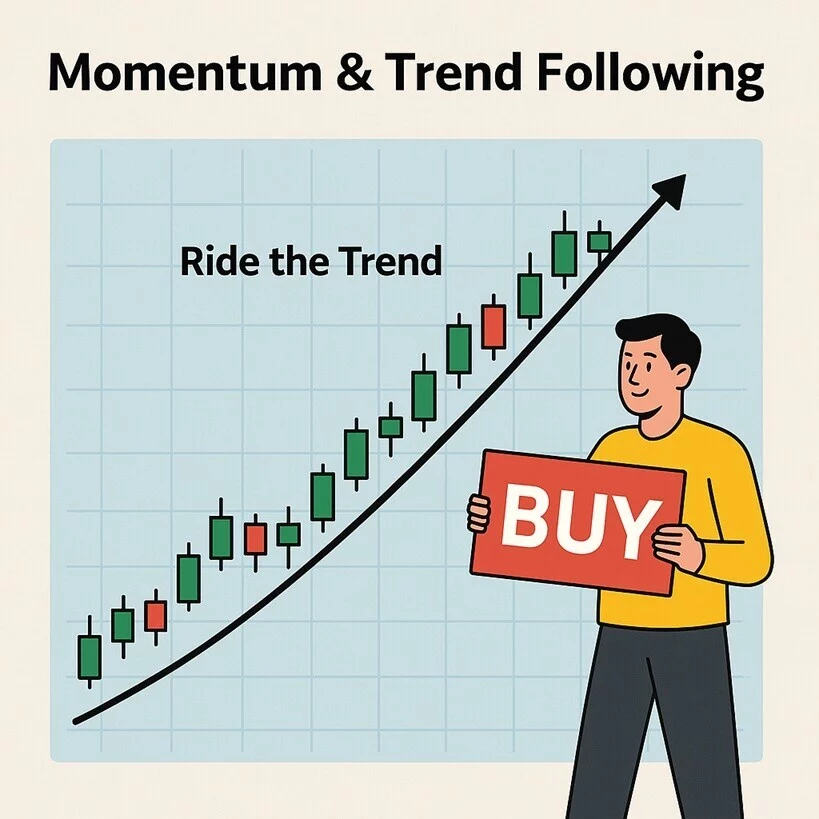When I first dipped my toes into stock trading, I was terrified. My paycheck barely covered rent, bills, and the occasional guilty splurge on lattes, but I wanted financial freedom. Trading looked intimidating, yet I realized that learning step by step could transform my finances and confidence. If you’re new like I once was, you don’t need to be a Wall Street insider—you just need discipline, strategy, and patience.
Table of Contents
The Path I’ll Walk You Through
Here’s how I’ll guide you in this article:
- Simple strategies I use and recommend for novices.
- Real examples of why they work in the real world.
- A focus on minimizing mistakes while maximizing learning.
- Insights on risk management, psychology, and emotional control.
- A dedicated FAQ section where I answer what most beginners ask.
- A clear conclusion that will motivate you to take your next step.
Let’s dive in, because waiting for the “perfect time” often means never starting at all.
Momentum & Trend Following: Riding the Market’s Wave
Momentum trading is one of the first approaches I learned. Essentially, you buy a stock moving upward and sell once its strength slows. Think of it like surfing—catch the wave, ride it, then jump off before it crashes.

I typically look at moving averages, RSI, and volume spikes. For example, when Apple’s stock crossed above its 50-day average after a strong earnings report, I knew momentum was on my side. I set a stop-loss to limit risk and sold when volume started drying up. That single trade taught me that momentum doesn’t require genius predictions—it requires discipline and timing.
The key here? Ride the trend but never get greedy. Greed whispers “just one more day,” but the market punishes hesitation.
Dollar-Cost Averaging (DCA): My Stress-Free Strategy
Not every investor loves surfing volatile waves, and that’s where dollar-cost averaging comes in. DCA means you invest a fixed amount regularly, regardless of price.
When I started, I set up automatic contributions into an S&P 500 index fund. On some days, I bought at highs, on others at lows. Over months, the average price balanced out, and I avoided the anxiety of trying to “time” the market.
For novice investors, DCA builds the discipline of consistent investing. You don’t wait for the perfect entry, because in truth, perfection rarely exists in markets.
Diversified ETFs: The Power of Variety
Diversification saved me from painful mistakes. In my early days, I bought individual stocks based on hype. Sometimes it worked, but often, one bad earnings report sank my portfolio. That’s when I discovered ETFs.
ETFs spread risk across dozens—or even hundreds—of companies. For example, instead of betting only on Tesla, I invested in a technology ETF covering Apple, Microsoft, Nvidia, and Tesla together. One bad quarter from Tesla no longer ruined my day.

If you’re new, ETFs help you dip your toes into multiple sectors. You get exposure to healthcare, energy, finance, and tech without picking winners and losers blindly.
Technical Analysis: Speaking the Language of Charts
Charts once looked like hieroglyphics to me. But with patience, I realized they tell stories of human behavior—fear, greed, hope.
I started with basics: candlestick patterns, moving averages, RSI, and MACD. My first win using technicals was spotting a bullish engulfing candle on Microsoft after a market dip. I bought shares, set a tight stop-loss, and exited with a neat profit in two weeks.
Learning charts doesn’t guarantee success, but it gives you an edge. It’s like learning traffic signals—you still may hit traffic jams, but you avoid running red lights.
Swing Trading: Finding the Sweet Spot
Swing trading became my personal favorite because it balances time and risk. Unlike day trading, which demands sitting glued to charts, swing trading allows positions over days or weeks.
For example, when AMD broke out of a consolidation pattern with strong volume, I entered and held for six days. The stock moved 15% in my favor, and I locked in profit. The beauty here is flexibility—you’re not rushed like a day trader but not waiting years like a long-term investor.
Risk Management: My Secret Weapon
I quickly learned that trading without risk management is gambling. Every trade I take now has two numbers: entry and exit. If I risk $100, I aim to make at least $300. That’s a 1:3 risk-reward ratio.
Stop-loss orders are my seatbelt. They may feel annoying when triggered, but they protect capital from disaster. I once ignored a stop on a biotech stock. It crashed 40% overnight after bad news, and I lost weeks of gains. Lesson learned: respect stops, respect discipline.
Psychology of Trading: Winning the Mental Game
Markets test emotions more than intellect. I’ve felt the panic of losses and the euphoria of gains. Both emotions tempt you to break your plan.
When I win, I journal why it worked. When I lose, I analyze mistakes. Over time, this habit improved my patience and reduced impulsive trades.
Trading isn’t just charts and numbers—it’s self-control. You don’t need to be the smartest; you need to be the most disciplined.
Tools and Platforms Beginners Can Use
When I began, I tried free simulators before risking real money. Platforms like paper trading accounts allowed me to practice strategies safely.
For analysis, I used free charting tools and upgraded gradually. I learned that beginners don’t need complex, expensive software. Start simple, master the basics, and upgrade only when your skills justify it.
My Video Pick for You
If you prefer learning visually, here’s one of the best starting points from my YouTube channel:
🎥 Trading for Beginners Part 1 – FULL TRADING COURSE (SuccessfulTradings)
It covers foundations every new trader should know, explained clearly and with step-by-step guidance.
FAQs — Common Beginner Questions
How much money should I start with?
I recommend starting with what you can afford to lose. I began with $500, but even $100 can teach valuable lessons.
How many strategies should I use?
Focus on one strategy at a time. For example, practice DCA or swing trading until you’re consistent before adding others.
Can I really make money as a beginner?
Yes, but slowly. Your first goal is learning, not profits. Profits come later when discipline meets experience.
Do I need both technical and fundamental analysis?
I use both. Technical analysis guides timing, while fundamentals ensure the company’s long-term health.
Is day trading a good idea when starting?
I don’t recommend it. Day trading requires speed, tools, and high risk tolerance. Build skills first with swing or long-term strategies.
What’s the biggest mistake to avoid?
Overtrading. Chasing every move drains energy and money. Pick your setups, wait patiently, and trade less but smarter.
Conclusion: Your Next Step as a New Trader
Stock trading intimidated me at first, but over time, I realized it rewards patience, discipline, and risk control—not luck.
If you’re starting today, keep it simple:
- Use DCA to build wealth gradually.
- Try momentum or swing trading to grow confidence.
- Diversify with ETFs to avoid single-stock disasters.
- Respect stop-losses and practice risk management.
- Focus on psychology—your mindset is your ultimate edge.
You don’t need to conquer Wall Street overnight. You only need to build steady habits today that lead to success tomorrow. Remember, markets reward consistency, not reckless speed.
Take a breath, start small, and stay curious—because this journey can absolutely change your financial life.

Hold a Master Degree in Electrical engineering from Texas A&M University.
African born – French Raised and US matured who speak 5 languages.
Active Stock Options Trader and Coach since 2014.
Most Swing Trade weekly Options and Specialize in 10-Baggers !
YouTube Channel: https://www.youtube.com/c/SuccessfulTradings
Other Website: https://237answersblog.com/
